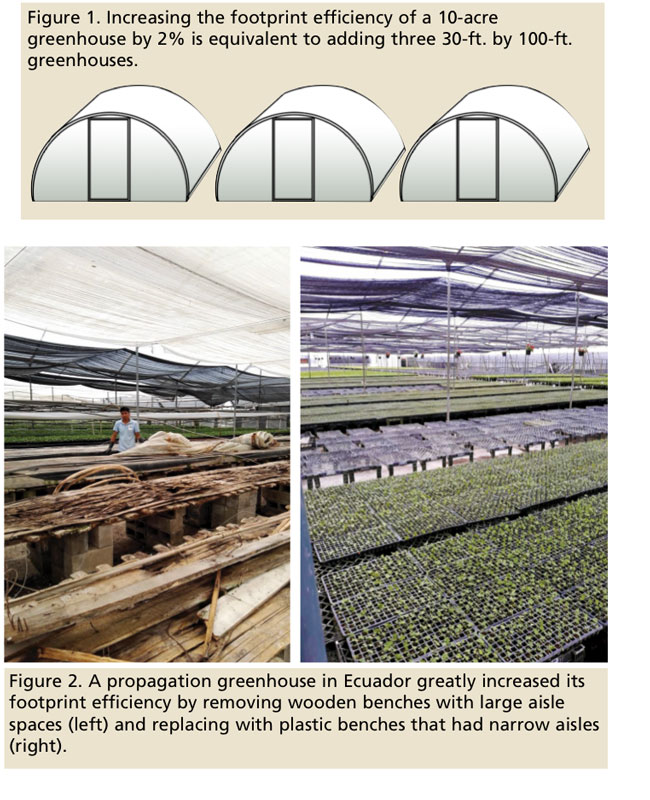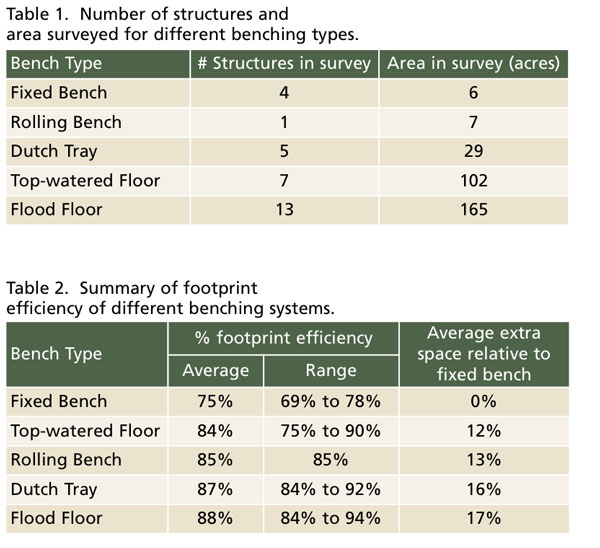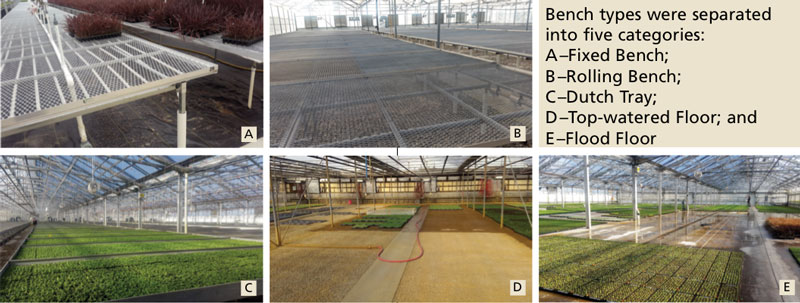10/1/2018
Making the Most of Your Space
Juan C. Vallejo, Paul R. Fisher & Alan W. Hodges

With increasing competition, it’s essential to understand your costs of production and eliminate waste in all resources. Greenhouse space is a major resource—wasted space increases many business costs, such as depreciation, heating, electricity, maintenance, use of land, water and fertilizer.
One way to measure efficiency of space use is to quantify the “footprint” that can be used for growing plants. This represents the productive area in the greenhouse, not including aisles and other dead spaces, such as along sidewalls. We define footprint efficiency as the proportion of total floor or bench space that can be effectively filled with plant containers.
We ran a study to quantify the “footprint space efficiency” of different benching systems. Over a 10-month period of time we visited 30 greenhouse structures at 21 different sites owned by 15 companies around the U.S., representing a total of 309 acres of production. Using a tape measure and floor plans, we measured the square footage available for plant growth. (We didn’t include hanging basket, field, germination room, head house, shipping or other space in the analysis.) Table 1 summarizes the number of structures visited and the total area surveyed for different benching types.
The results for our survey are summarized in Table 2. Main findings were:
• Fixed benches tended to be the least-efficient benching system with an average of 75% of use.
• Top-watered floors generally had greater efficiency than fixed benches because of smaller aisle width, even though they were also a simple technology choice.
• The average footprint efficiency for the other four systems was similar, between 84% and 88%, with Dutch trays and flood floors coming out slightly ahead.
• Within each bench type, there was considerable variation (for example, 84% to 94% for flood floors or from a dreadful 69% up to a respectable 78% in fixed bench). This emphasizes that careful design is important even with an efficient bench type.
• The most efficient greenhouse had 94% footprint efficiency, compared with 69% for the least-efficient location.
• Across all locations and bench types, footprint efficiency averaged 85%.
These results have important practical take-home messages:
 • If you currently have fixed benches, it’s likely to be the least-efficient benching system. Consider changing to a different system.
• If you currently have fixed benches, it’s likely to be the least-efficient benching system. Consider changing to a different system.
• The average footprint efficiency was 85%. If you’re less efficient than this benchmark, there’s probably potential for improved efficiency. Regardless of your benching system, minimize lost space around aisles and side walls.
• If you can gain 10% more footprint efficiency, for example from 80% up to 90%, you just cut all your fixed costs (depreciation, utilities) per unit of plant product by more than 10%.
• Invest in product transport systems, such as rails or conveyors, that allow minimal aisle space or have a movable aisle with Dutch trays or rolling benches.
It’s important to squeeze out every inch of usable space, especially if you have limited land available. One way to visualize this concept is to take the example of a 10-acre greenhouse (435,600 sq. ft.). If it was possible to reduce dead aisle and sidewall spaces that improved footprint efficiency by 2%, this would provide around 9,000 sq. ft. of extra production. That would be the equivalent of three 30-ft. x 100-ft. Quonset greenhouses without the need to build heating and irrigation systems, or cooling or lighting new structures (Figure 1).
One of the authors of this study, Juan Carlos Vallejo, manages a large cut flower export operation. After running the space efficiency study in the U.S., he applied those concepts to one of their facilities in Ecuador. A fixed-bench system with wooden benches on concrete blocks was removed from a 32,292 sq. ft. propagation greenhouse and changed to plastic benches with a smaller aisle space (Figure 2). Space footprint increased from 68% to 86% with this change, greatly reducing overhead costs.
 In this article, we emphasized the economic value of improving footprint efficiency in your operation. Measuring the footprint is also a necessary step to allocate overhead and labor. The next step to quantify area and time used by plants (“square foot weeks”), which we will discuss in next month’s article, is to track the “space use efficiency”—how full your greenhouse is with plants each week of the year. GT
In this article, we emphasized the economic value of improving footprint efficiency in your operation. Measuring the footprint is also a necessary step to allocate overhead and labor. The next step to quantify area and time used by plants (“square foot weeks”), which we will discuss in next month’s article, is to track the “space use efficiency”—how full your greenhouse is with plants each week of the year. GT
Acknowledgements: We thank the industry sponsors in the Floriculture Research Alliance (floriculturealliance.org) and USDA-ARS Floriculture and Nursery Research Initiative #58-3607-8-725 for supporting this research. This study was conducted under IRB-02 guidelines.
Juan C. Vallejo, Paul R. Fisher and Alan W. Hodges are with the University of Florida IFAS, in Gainesville, Florida.